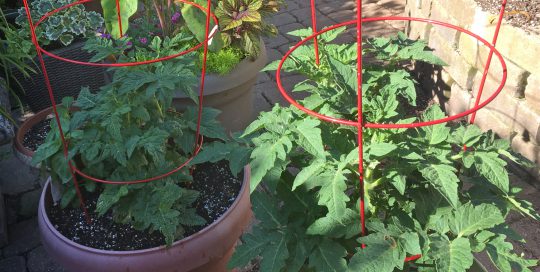Grow Your Own Tomatoes!
There’s nothing better than homegrown, ripe juicy tomatoes. They offer great flavor and better texture than just about any tomato you can find in the local produce section. If you planted tomatoes in your garden this spring, the first fruits of your labor should be evident any day now. By early summer, healthy tomato plants will have plenty of flowers along with small green fruits. In some parts of the country, tomatoes are already ripening.
They’re an easy-to-grow crop, but like every vegetable, they can have problems. A common question among gardeners is “why did my tomato plant stop producing?” Knowing what type of tomato you’re growing may help answer that question.
Tomato Types
Tomato plants typically fall into one of two categories: Indeterminate and determinate. Indeterminate (climbing) plants, such as Big Beef, Brandywine and Cherokee Purple, continue growing until frost. The plants may have flowers, immature fruit and ripe fruit all at the same time. They can grow several feet and they need a support.
Determinate plants, such as Celebrity, Marglobe and Better Bush, are more bushy and compact and tend to grow all their flowers and fruits at the end of the stems. They produce all of their fruit over a period of two weeks or so and then the plant stops growing. As the fruit ripens, the plant starts to shut down. Determinate types are good for those gardeners who wish to freeze or can the tomatoes for winter use.
The Well-Trained Tomato
Indeterminate plants grow best when the vines stand upright and are held off the ground. If you let them sprawl, you’ll get more fruits, but they will be harder to pick, the stems may crack as you move them and the fruit can rot if it’s sitting on the soil. Stake, trellis or cage them for the best results. For example, plants trained to a tall metal or wood stake will produce fewer, but larger fruits that are easier to harvest than if the vines are left to sprawl. Once flowering begins, the tomato vines must be routinely tied to the support with twine or cloth strips to keep the stems from cracking under the weight of the fruit.
Pinch, pinch
Check plants every 5 to 7 days for tiny shoots called suckers. Suckers grow at the junction of a main stem and just above a set of leaves. Removing suckers helps the plant put its energy into creating more flowers and fruit. Simply bend and snap the sucker off with your fingers. Suckers left on the plant will grow just like the main stem, producing flowers and fruit. However, the farther up the plant a sucker develops, the weaker that new stem becomes. It’s often easiest to keep three or four main stems on the plant and tie each one to the support. According to tomato guru Craig LeHoullier, who developed the tomato known as Cherokee Purple, you can put the suckers in a cup of water where the stem will develop roots. Try planting the rooted suckers in July for a fall harvest of late tomatoes.
Care and Feeding
Some things can cause tomato plants to produce poorly. They grow best in a spot that receives at least six hours of direct sunlight, but eight hours is even better. If the plants are not producing plenty of flowers, they may need more sunlight. When the temperatures climb above 85 degrees during the day or drop below 55 degrees at night, flowers may fall off and consequently you won’t have fruit until the weather cooperates.
Fertile, well-draining soil is a must and healthy plants need adequate water. When there’s a drought, the soil needs a good, deep soaking. Tomato plant roots can go down 8 to 12 inches deep so let the hose dribble slowly until that area is sufficiently wet. That’s important because drought-stressed plants are more susceptible to insects.
Too much nitrogen in the soil can cause rampant growth and soft tomatoes that are susceptible to rot. Soil test kits, which can tell you how much nitrogen is present, are sold at local garden centers. Use a balanced (10-10-10) water-soluble fertilizer every two weeks or so to keep plants growing. And, to keep weeds in check, mulch around the plants with an inch or so of compost.
Keep an eye out for tomato hornworms, long green caterpillars that can quickly devour the leaves and stems of plants. You can pick them off and drop them in a bucket of soapy water.
Resources
Each county in the U.S. has a Cooperative Extension Service office, staffed with folks who work closely with university-based Extension specialists to answer questions about gardening, plant diseases and pest control. Visit the link and click on your state to find a local office.
For a fascinating look at tomatoes and everything you need to know about growing more than 200 varieties, check out Craig LeHoullier’s book, “Epic Tomatoes,” (Storey Publishing, 256 pages, $19.95).










